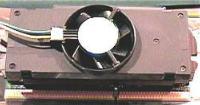Retail Boxed, OEM and the difference
For quite some time now, many have theorized that Intel "cherry-picks" the silicon core for retail sale. After all, if the core stepping and CPUID are the same, then what else would explain the widely reported difference in results with the two different versions of the chip?
After this weeks testing, as well as the correspondence I received from some of those "in the know", I am now convinced that this is true, although cherry-picking isn't exactly the right term; that would be too time-consuming. Once again, let me remind you that the following is my opinion pieced together from my own experience and information provided from others.
From what I've been able to gather, and this weeks testing confirms this, at least in my own mind, is the center of the silicon wafer tends to be more consistent throughout and therefore of higher quality. Intel has always cut the retail boxed version's silicon from this center.
Several ex-Intel fab employees, as well as a couple ex-Intel design engineers sent me compelling arguments demonstrating that this is the procedure. To a person, they were consistent in this assertion. And, to a person, they requested anonymity because of confidentiality agreements. I will honor that request, no matter how I am tortured.:-)
In the earlier stages of Celery production, demand for OEM processors far outstripped that of retail versions. This is because all the "Big Guys" use the OEM version. So, since the need for Retail versions of the chip was low, much of the "sweet-spot" of the wafer went to OEM production.
In the later stages, particularly after production of the 366 and 400 began (yes, they've actually been in production for a while, now), more of the "good stuff" was needed. The 366 and 400 obviously need a higher quality core, regardless of version, so less of the center was left for OEM 300A production.
This is why, while the OEM version of the CPU still hovers around the 90% range for overclockability, an increasing number of the chips require a goose in the core voltage in order to achieve this goal. At the same time, the Retail version of the 300A was still being cut from the center!
And now a few photos to aid you in your quest!
The difference illustrated
The Retail Celery and OEM Celery sticks
 Retail front |
 Retail back |
|
|
When I first saw the fan mounted on one of these puppys I thought it looked a little wimpy. Upon closer investigation and testing, I've concluded that Intel's engineers knew exactly what they were doing. There are two key design features that I believe make this a very efficient cooler.
First, the fan does not touch the heatsink. It is mounted with a gap, so that it circulates air over the heatsink and dissipates heat out of each end. Second, note the metal plate on the back of the CPU? This is integral to the clamps that hold the heatsink on the front and serves the additional function of cooling the area directly behind the silicon. Even at 450Mhz, this area is barely warm to the touch.
The retail box.

Label from a Retail box.
The numbers SL32A tell us that this is a
Retail version. The packing date doesn't seem to be of great relevance since I had a
couple different label/PCB dates with the same packing date. And the number
"98480238" will correspond to the number that appears on the white label on the
back of the CPU:

Note: Numbers different as these are different CPU's.
I honestly have no idea what all the other numbers mean, so if any of you have further
information on this, send it in and I'll pass it on.
Now that you're armed with some photos, let's move on to
the report, but first.....











0 Comments
View All Comments